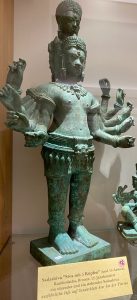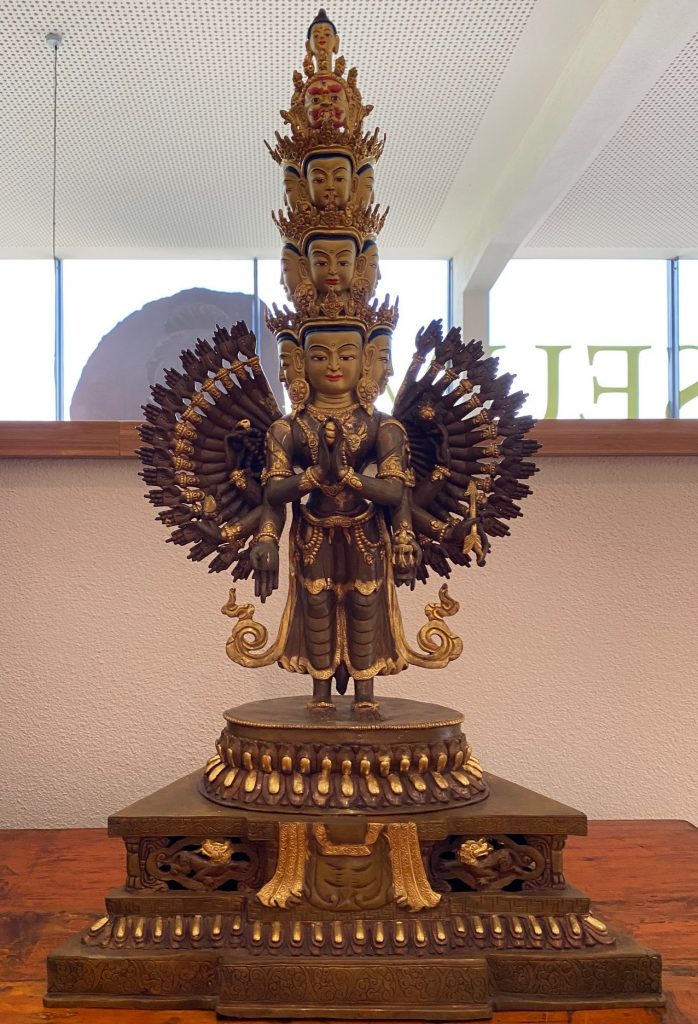With the recent Korean uprising against the imposition of martial law the world has witnessed a successful defense of democratic rule in South Korea. International politics has quickly moved on to other areas of the world where people’s struggle to obtain or sustain the freedom to vote and the freedom of expression.
However, the Korean history of uprisings goes back a least as far as the beginning of the Cold War period with the separation in 2 Koreas. The 1980 uprising of student protests in South Korea was extinguished with brutal force and mass killings. Can literature heal the wounds of uprisings? Only the best of literature can. The Korean female author and poet Han Kang (Nobel laureate 2024) has accomplished this. In the novel 소년이 온다 “Human acts” (English title), “Celui qui revient” (French), ”Menschenwerk” (German) the Gwangju Uprising 1980 is the historic backdrop against which the loss of human dignity during dictatorships is narrated. Han Kang manages to depict the empathy of family members who are confronted with the brutality of the military forces. It is tough on readers as they become the witnesses of the violence described as such and the sorrow of the whole social environment of the victims.
The Nobel Prize for literature 2024 honors the “world literature” aspect of Han Kang’s writings over many years. Many prizes have been allocated for representative writers (80+ % were men) of a country. The different titles of professional translators chosen for this novel reveal the potential to link to very different national narratives and connections to national memory of uprisings. Translating literature from different cultures can be challenging as readers frequently want the narratives somehow to relate to their own “endured” experiences. World literature, just like world history, goes beyond this and takes the reader by the hand and broadens emotional and human horizons.
(Image: Gallery Lee Bouwens, Brussels, exposed Jungjin Lee Voice #02, Voice #26 in 2025, inkjet pigment prints, Jungjin Lee) 
Korea relieved
On Saturday 14th of December 2024 the Parliament of Korea voted with 204 out of 300 votes, the required 2/3 majority of the parliament to dismiss the president. The declaration of martial law has been the most serious attack on democracy in Korea since its founding in 1987. It is the 3rd impeachment of a Korean president in this short time of democratic life cycle. After impeachment the constitutional court has to confirm the impeachment also with 6 out of 9 judges in favor of impeachment. In 2017 the judges confirmed the impeachment of a president due to corruption charges, but in 2004 another president was reinstated after illegal campaigning charges were retracted. Democratic procedures hinge on checks and balances in the constitutional set up of a state. Nominations, votes of confirmation of judges are important safeguards against illegal martial laws to restrict or even abandon democracy. Pressure from the street, the people at large, is another safety net of democracy. It should not be the last resort for democracy’s survival as it is likely to come at high costs of human lives. 
Fiscal Union
European Integration is slow and hard to come by. For others it is moving too fast (Brexit). Cultural diversity is a real asset of the EU. The economy or the economies are powerful on an international scale. Nevertheless, the diversity concerning the tolerance of fiscal deficits is still widely spread across the Member States of the EU (see image below). Some states seem to play it cool and run relatively high deficits compared to the EU averages. In OECD comparisons most of the above average fiscal deficits are closer to or even below OECD averages over time (link to pdf-file OECD, 2024). Within the EU differences in government expenditure as % of GDP or the indicator of Gross public debt according to the Maastricht Criteria range from 20% to 160% as percentage of GDP. This entails a different level of resilience to future crises. After we managed to leave the previous 3 crises (financial, Covid-19, energy) it is time to prepare for what might come next in terms of challenges. Preparing public deficits to be able to soften economic shocks is essential to be able to sustain yourself and support others. We seem to be a bit off-target to coordinate fiscal deficits across the Union. Eastern and Northern countries have suffienct scope to support expansionist fiscal policies, be it in the realm of a defence union or to address climate change. Southern Europe will find it more difficult to raise additional funds to prepare now for future challenges. Fiscal deficits might even be not only an economic phenomenon, but a cultural one as well. If we compare Japan with a deficit running at 240% with South Korea with 50% Asia is showing even larger diversity in terms of fiscal preparedness.
An economist’s stance on fiscal policy and fiscal union might depend much more on her/his region or country of origin than economists might want to believe.
Images: OECD Economic Surveys: Belgium 2024, OECD Publishing, Paris, https://doi.org/10.1787/c671124e-en. p.17. 
Buddha Museum
In Fortführung des Themas “Geben und Nehmen” bot sich der Besuch des Buddha-Museums in Traben-Trarbach an. Als zentrales Thema gehört das Geben von Opfergaben, aber auch das Nehmen auf Seiten der Mönche zum buddhistischen Alltag. Durch das Geld als Tauschmittel hat das Geben, in Form von Naturalien oder zubereiteten Speisen, im Westen seine Bedeutung verloren. Die Armenspeisung oder Versorgung mit Lebensmitteln für Bedürftige hat sich in der caritativen Arbeit erhalten. Ansonsten ist der Tausch über Geld als Zahlungsmittel die kontaktlose Form des Gebens und Nehmens geworden. So hat mich am Buddha-Museum eigentlich überrascht, dass es einen festen Eintrittspreis gab, im Gegensatz zu Gotteshäusern anderer Religionen. Dies führte wohlmöglich zu der Besuchsruhe als fast alleinige Gäste an einem touristisch viel besuchten Wochenende im Juni 2021. Die Sammlung im Museum überzeugt durch die historische Tiefe (bis ins 12. Jahrhundert) und geografische Breite (weite Teile Asiens) der Buddha-Repräsentationen. Über Inhalte der buddhistischen Lehre informieren viele Tafeln neben den Figuren. Ansonsten bietet sich das Meditieren an zum Beispiel im Innenhof oder auf der Dachterrasse. Viel Zeit mitbringen ist notwendig. Als Beispiele habe ich eine kleine persönliche Galerie zusammengestellt. Beschleunigung und Aufgabenfülle treibt selbst die Buddha-Repräsentationen (siehe Abbildungen unten). Während die frühen Darstellungen noch mit wenigen zusätzlichen Händen auskommen, haben spätere Darstellungen bereits viel mehr Arme und fast genauso viele Köpfe, um die Arbeiten für die Gläubigen zu erledigen. Während zusätzliche Arme die Statue stabilisieren, werden weitere Etagen mit Köpfen selbst den Buddha sehr kopflastig werden lassen. Ist das Gesamtbildnis bereits gefährdet? Wir bleiben dran an der Story.
 Die ausgewählte Buddhafigur (erste Abbildung) ist ein Geschenk des Königreichs Bhutan an das Buddha-Museum aus dem Jahr 2012. Eine Lehmfigur mit Naturfarben. Eine Weiheinschrift befindet sich versiegelt im Inneren. Laut Beschreibung hielt die Gesandte des Königs die Figur während des gesamten Fluges auf ihrem Schoß. Meditation mit Halten einer Buddhafigur ist auch schon eine beachtliche Leistung. Medienabstinenz ist für die jüngere Generation in 2021 kaum noch vorstellbar. Das sehen sicherlich unsere Gerichte schon so. Handyverbot ist Grundrechtsberaubung, da Informations- und Mein
Die ausgewählte Buddhafigur (erste Abbildung) ist ein Geschenk des Königreichs Bhutan an das Buddha-Museum aus dem Jahr 2012. Eine Lehmfigur mit Naturfarben. Eine Weiheinschrift befindet sich versiegelt im Inneren. Laut Beschreibung hielt die Gesandte des Königs die Figur während des gesamten Fluges auf ihrem Schoß. Meditation mit Halten einer Buddhafigur ist auch schon eine beachtliche Leistung. Medienabstinenz ist für die jüngere Generation in 2021 kaum noch vorstellbar. Das sehen sicherlich unsere Gerichte schon so. Handyverbot ist Grundrechtsberaubung, da Informations- und Mein ungsfreiheit darüber ausgeübt werden. “Geben und Nehmen” über den Lebensverlauf ist nicht nur eine Meditationsreise wert, es beschreibt ein soziologisches Forschungsprogramm von großer Tragweite. Theoretische und empirische Durchdringung ist anspruchsvoll, beginnt doch das Leben von der ersten Zellteilung an mit dem Nehmen, aber auch dem Geben von genetischen Programmen. Dann sehen wir ein weiteres “Phase-in” des Gebens über den Lebensverlauf auf vielfältige Weise. Wollen oder sollen wir das bilanzieren? Den Menschen ist das weitesgehend freigestellt, Tieren weniger. In Annäherung an das Lebensende stellen sich viele Menschen erneut diese Frage des Gebens und Nehmens auf existentielle Weise. Die neue Bewertung der Sterbehilfe als neue Balance von Geben und Nehmen am Lebensende beendet vermeintlich den Lebensverlauf, die intergenerationellen Fragen wie Vererbung und Ungleichheiten schreiben jedoch den Zyklus des Gebens und Nehmens fort.
ungsfreiheit darüber ausgeübt werden. “Geben und Nehmen” über den Lebensverlauf ist nicht nur eine Meditationsreise wert, es beschreibt ein soziologisches Forschungsprogramm von großer Tragweite. Theoretische und empirische Durchdringung ist anspruchsvoll, beginnt doch das Leben von der ersten Zellteilung an mit dem Nehmen, aber auch dem Geben von genetischen Programmen. Dann sehen wir ein weiteres “Phase-in” des Gebens über den Lebensverlauf auf vielfältige Weise. Wollen oder sollen wir das bilanzieren? Den Menschen ist das weitesgehend freigestellt, Tieren weniger. In Annäherung an das Lebensende stellen sich viele Menschen erneut diese Frage des Gebens und Nehmens auf existentielle Weise. Die neue Bewertung der Sterbehilfe als neue Balance von Geben und Nehmen am Lebensende beendet vermeintlich den Lebensverlauf, die intergenerationellen Fragen wie Vererbung und Ungleichheiten schreiben jedoch den Zyklus des Gebens und Nehmens fort. 

